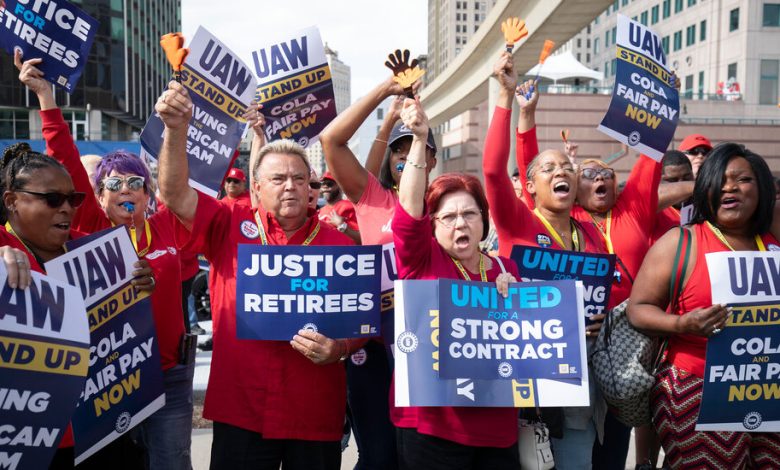U.A.W. Does Not Expand Strikes at Automakers

The United Automobile Workers union said on Friday that it had made progress in its negotiations with Ford Motor, General Motors and Stellantis, the parent of Chrysler, and would not expand the strikes against the companies that began three weeks ago.
In an online video, the president of the union, Shawn Fain, said G.M. had agreed to include workers at its battery factories in the company’s national contract with the U.A.W. G.M. had previously said that it could not include those workers because they are employed by joint ventures between G.M. and battery suppliers.
“Here’s the bottom line: we are winning,” Mr. Fain, wearing a T-shirt that read “Eat The Rich,” said. “We are making progress and we are headed in the right direction.”
Mr. Fain said G.M. made the concession on battery plant workers after the union had threatened to strike the company’s factory in Arlington, Texas where it makes some of its most profitable full-size sport-utility vehicles, including the Cadillac Escalade and the Chevrolet Tahoe. The plant employs 5,300 workers.
G.M. has started production at one battery plant in Ohio, and has others under construction in Tennessee and Michigan. Workers at the Ohio plant voted overwhelmingly to be represented by the U.A.W. and have been negotiating a separate contract with the joint venture, Ultium Cells, that G.M. owns with L.G. Energy Solution.
Ford is building two joint-venture battery plants in Kentucky and one in Tennessee, and a fourth in Michigan that is wholly owned by Ford. Stellantis has just started building a battery plant in Indiana and is looking for a site for a second.
Mr. Fain said all three companies had agreed to significantly improve their offers to the union, including providing bigger raises and offering cost of living increases.
The strike began Sept. 15 when workers walked out of three plants in Michigan, Ohio and Missouri, each owned by one of the three companies.
The stoppage was later expanded to 38 spare-parts distribution centers owned by G.M. and Stellantis, and then to a Ford plant in Chicago and another G.M. factory in Lansing, Mich. About 25,000 of the 150,000 U.A.W. members employed by the three Michigan automakers were on strike as of Friday morning.

Here Are the Locations Where U.A.W. Strikes Are Happening
See where U.A.W. members are on strike at plants and distribution centers owned by Ford, General Motors and Stellantis.
The contract battle has become a national political issue. President Biden visited a picket line near Detroit last month. A day later, former President Donald J. Trump spoke at a nonunion factory north of Detroit and criticized Mr. Biden and leaders of the U.A.W. Other lawmakers and candidates have voiced support for the U.A.W. or criticized the strikes.
When negotiations began in July, Mr. Fain initially demanded a 40 percent increase in wages, noting that workers’ pay has not kept up with inflation over the last 15 years and that the chief executives of the three companies have seen pay increases of roughly that magnitude.
The automakers, which have made near-record profits over the last 10 years, have all offered increases of slightly more than 20 percent over four years. Company executives have said anything more would threaten their ability to compete with nonunion companies like Tesla and invest in new electric vehicle models and battery factories.
The union also wants to end a wage system in which newly hired workers earn just over half the top U.A.W. wage, $32 an hour now, and need to work for eight years to reach the maximum. It is also seeking cost-of-living adjustments if inflation flares, pensions for a greater number of workers, company-paid retirement health care, shorter working hours and the right to strike in response to plant closings.
Striking at only select locations at all three companies is a change from the past, when the U.A.W. typically called for a strike at all locations of one company that the union had chosen as its target. Striking at only a few locations hurts the companies — the idled plants make some of their most profitable models — but limits the economic damage to the broader economies in the affected states.
It also could help preserve the Union’s $825 million strike fund, from which striking workers are paid while they’re off the job. The union is paying striking workers $500 a week.
G.M. said this week that the first two weeks of the strike had cost it $200 million. The three automakers and some of their suppliers have said that they have had to lay off hundreds of workers because the strikes have disrupted the supply and demand for certain parts.



